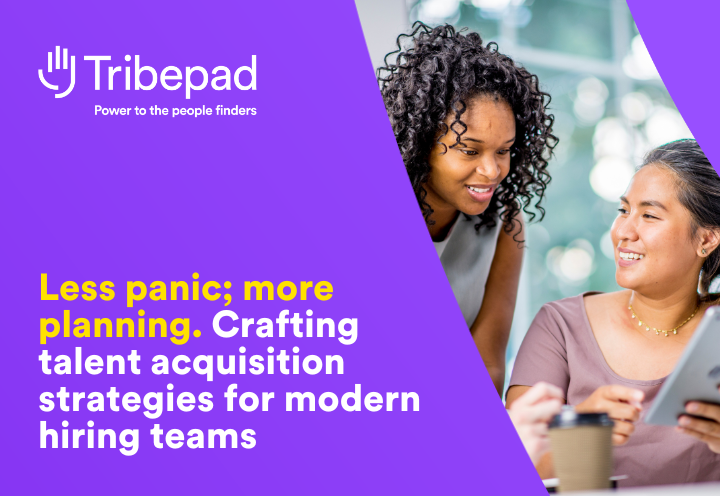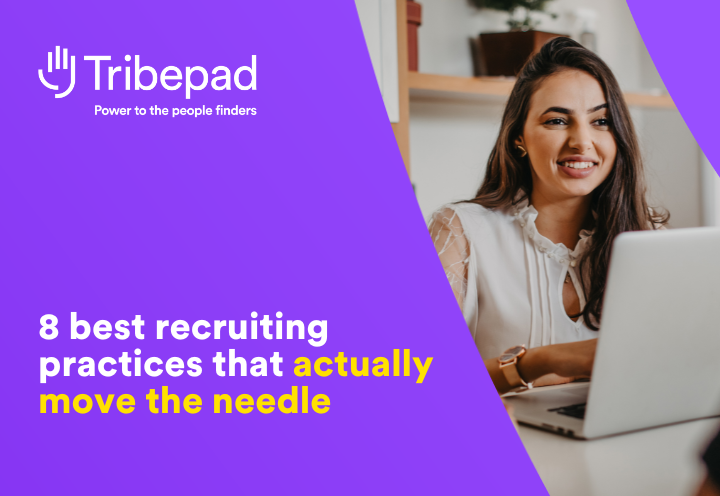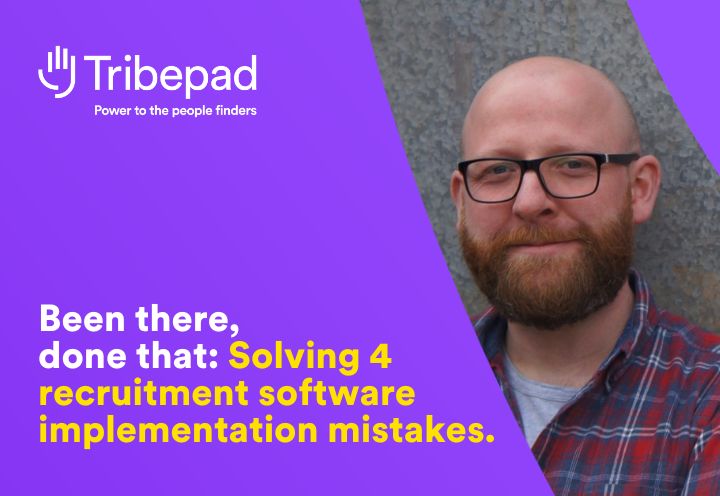In this guide, we unpick the essentials about candidate experience in recruitment—or CX, as it’s abbreviated.
Keep reading to learn:
- What is candidate experience, really, and why does it matter?
- What are CX best practices and how can you integrate them?
- How can you measure candidate experience?
Let’s go.
What is candidate experience in recruitment?
Candidate experience has become a major buzzword—but what actually is candidate experience? In essence, CX is about how candidates feel throughout your recruitment process.
It’s a simple term that’s also somewhat nebulous, because it doesn’t refer to any single practice or process. Recruiters often talk about “the candidate experience” as if it’s a single entity, but CX is inherently multifaceted and fragmented.
You might create a fabulous video that blows candidates away (BA is a great recent example), say. But then you’re inundated with applications, so you don’t get to everyone fast enough.
So ultimately those same candidates who had a WOW experience are now feeling BLEURGH. Perhaps even more so than if they’d not been so excited to apply because of your brilliant video. You’ve raised your own bar.
When we talk about candidate experience, we’re talking about those micro-experiences at every stage in your process. But we’re also talking about the interplay and cumulative impact of those experiences for candidates.
What this really means is, taking control over CX is complex. Hence why we’re all still talking about it…
Why is candidate experience important?
At the pointy end, recruiters’ main success metric is placements:
- Have you successfully hired the people the organisation needs?
- Have you met headcount (and budget) targets?
- Does the business have the right people to meet its goals
So why do we care about how candidates feel? Why is candidate experience important, when that’s not (usually) the main KPI we’re judged against?
The reason is, candidate experience underpins everything.
CX certainly isn’t the only factor that determines hiring success. But it’s extremely hard to build a recruitment function that’s effective and sustainable long-term unless you’ve mastered candidate experience.
A positive candidate experience makes it easier, cheaper, and faster to hire the right people. And those gains gather momentum over time, helping you edge ahead of competitors until they’re eventually only a speck in your rear-view.
But on the flipside, if your recruitment function is slowly stagnating – if you’re watching competitors slowly edge ahead of you – and you can’t work out why, the answer often relates to candidate experience.
The downwards spiral of a poor candidate experience:
- Falling application volume
- Mid-process withdrawals
- Curt candidate calls
- Ignored interview requests
- Declining application quality
- Declined job offers
- Unhappy hiring managers
- Poor reviews and reputation
- Jobs getting harder to fill
- Increasing recruitment costs
- Pressure from the C-suite
- A workforce that can’t meet business needs
- Declining productivity and revenue performance
Let’s talk about candidate experience best practices, then we’ll explore some practical actions you can take to improve candidate experience.
Seven candidate experience best practices
What makes a great candidate experience? There’s no single path to delivering excellent CX, but there are some general principles that hold true across the board:
- Transparent. Keep candidates informed about their application progress, and the recruitment process they can expect.
- Fast. Prove you value candidates’ time with fast, modern, efficient processes. Nobody likes kicking their heels.
- Convenient. Create a recruitment journey that fits around candidates’ busy lives, without faff and hassle.
- Fair. Treat candidates fairly, without discrimination. Inspire trust in your culture of equality, diversity, and inclusion.
- Supportive. Decrease the anxiety of job-seeking. Help candidates navigate your process easily, so they can put their best foot forwards.
- Respectful. Treat candidates as people, not numbers. Imagine if even unsuccessful candidates could benefit from engaging with your process.
- Human-to-human. Deliver a personal recruitment experience that helps candidates trust they’re choosing the right role and organisation.
Here’s what those principles could look like in practice.
How to improve candidate experience: practical tactics
End ghosting for good
Our 2023 End Ghosting report found that fewer candidates are being ghosted than the year before but the issue is still prevalent: 43% of candidates were ghosted by a potential employer last year.
That’s a huge problem because ghosting has a huge impact on candidates, derailing candidate experience from the get-go. Our research found that an astonishing 87% of candidates who have been ghosted say they’re left feeling down or depressed.
If you’re not 100% sure that 100% of your candidates are getting a timely, considerate response, this should be your immediate focus area for improving CX.
The right recruitment software should make this super simple. For instance, with Tribepad you can:
- Create template emails with common rejection reasons then automate delivery when you reject a candidate or fill the role.
- Provide candidates with easy application updates via a self-service portal that automatically updates in real-time as your process progresses.
- Send candidates SMS to keep candidates informed about their application status, interview updates, and any changes in the hiring process.
- Add workflow stages to remind hiring managers to email or call unsuccessful interviewing candidates with feedback.
Read more: 13 Tribepad features to End Ghosting
Accelerate time-to-hire
Slow internal processes are a huge issue for many teams, from growing organisations of 50 people to enterprises with 50,000. Slow time-to-hire is a poor candidate experience, and it also means you’re likely losing out on great people. Especially for high-volume, entry-level roles, candidates often prioritise the opportunity that arrives first.
The early bird really does catch the worm, in almost every case. Great communication will buy you some time but it’s not a silver bullet.
Getting candidates through the door faster isn’t only about having the right talent tech. There’s also a hefty dose of stakeholder education and engagement, and your internal processes probably need some attention.
But good software is a huge part. Look for software with lots of functionality designed to process candidates faster and make collaboration with hiring managers easier and faster.
That can include features like:
- Automated comms
- Automated workflows
- Bulk actions
- Templates and cloning
- Multiple location jobs
- Job board integrations for quick distribution
- Speedy interview scheduling
- Killer questions and pre-screening
- Automated checks
- Talent pooling and tagging
- Contract management and onboarding
Read more: 15 ways to automate your recruitment process
It should also make flexible configuration simple, to speed up how you work rather than wedging you into processes that don’t fit your organisation. Modern reporting functionality is an absolute must-have too, so you can scrutinise your own data to spot problems, prioritise action, and track progress.
Read how Tribepad helped Well Pharmacy decrease time-to-offer for specialist roles by 35% 😎
Make candidates’ lives easy
Your candidates might be applying to tens, even hundreds, of roles. And they might be juggling their current role at the same time. They simply don’t have time for faffy, time-consuming processes that don’t respect their time or situation.
Your software should help you keep candidate experience at the heart of your process, without creating extra work for recruiters.
For example, with Tribepad, candidates can create a profile, upload a CV, and apply for a job in under two minutes—that’s a speedy, seamless process. Our talent acquisition software has heaps of features to make candidates’ lives easier. Like:
- Mobile-apply and social media apply
- One-click CV import
- Candidates can attach supporting docs
- Speedy mobile-first application journeys
- Responsive on any device
- Anytime, anywhere video interviewing
- Self-book interviews
- SMS and email communication
- Digital contracts and signatures
- Automated reference collection
- Self-service candidate portal to track application
Watch Andrew Wood, co-founder of Home Instead, and Ursula Jayes, co-founder of Relish Recruitment talk about the candidate experience in the care sector: WATCH NOW.
Build an inclusive process
Building a fair, inclusive recruitment process is essential to building a representative workforce that can deliver better outcomes for the organisation and the communities you serve. Any CX initiative must consider how to improve candidate experience for everyone.
Watch Fosway talk to Tribepad about ED&I: WATCH NOW
That’s a tech, people, and process challenge.
- Do you have the right internal processes to support ED&I, like inclusion training for hiring managers, ED&I events, and consistent ED&I feedback?
- Do you have the right recruitment software, to tackle unconscious bias, support diversity-forward processes, and power granular diversity reporting?
- Do you have the right people internally to champion and progress ED&I initiatives, and co-create the culture you want?
- Have you scrutinised how you use AI, to ensure the impact is positive for you and jobseekers alike?
- Are you considerate of everyone’s support needs? Tribepad’s integration with Recite Me is a great example of making inclusion second nature.
Read more: 12 hands-on way to build a fair recruitment process and culture
Educate and empower hiring managers
Hiring managers can be one of the biggest hurdles to improving candidate experience. They’re busy with business-as-usual, and they often don’t totally buy into recruitment or understand what good looks like — but this can translate into slow, inconsistent candidate experiences.
To drive change here, you need managers to understand what’s needed from them and why, and you need those actions to be simple. Then managers become partners in your mission to improve candidate experience, not problems.
That’s partially about education — think providing resources; training; cross-functional workshops; creating governance — and partially about empowering them with the right tools.
If your current recruitment software* is clunky, unintuitive, slow, and hard-to-use, you’ll always be facing an uphill battle to change manager behaviour. It also helps if your software empowers granular reporting so you can get a comprehensive picture of manager behaviour. You can’t change what you can’t see.
*And forget about improving collaboration if you’re still using spreadsheets.
The human touch
“Recruitment is a human-to-human interaction”, as Head Analyst at Fosway, Sven Elbert, emphasised recently in our chat about the impact of AI in recruitment.
We’ve talked a lot about recruitment software here but it’s crucial we don’t forget: the role of technology is to free space for recruiters to add more personal value. The goal is never to replace human interaction.
Sure, software helps you get the foundation of candidate experience right—like stopping ghosting candidates or banishing dinosaur application processes with seven million questions.
But it’s the above-and-beyond human moments that can really make a difference for candidates. The right tech makes you more efficient so you have time to create them.
Some ideas:
- Developing your EVP and creating stand-out employer branding content
- Spending longer talking to candidates to understand their true career needs
- Showing candidates around your offices and answering all their questions
- Developing a recruitment resource pack to support interviewing candidates
- Calling candidates with personalised feedback post-interview
- Creating a personalised video to welcome new hires to the pack
- Sending new hires a welcome card with messages from their team
How to measure CX with candidate experience surveys
There’s no point investing time, resources and energy into improving candidate experience if you don’t measure progress. Measuring CX helps you spot improvement areas and prove your value upwards to the C-suite: it’s critical.
The most direct way to measure CX is through candidate experience surveys. This takes the qualitative nature of CX and helps you apply a more objective lens, giving you a baseline to improve against in the future.
Combined with your core recruitment metrics, candidate experience surveys help you identify what’s working and what’s not within your process.
The best format is short and sweet to maximise uptake, especially among unsuccessful candidates. This feedback can be enormously valuable.
If you’re also planning to conduct surveys with new hires (which makes a heap of sense and is good onboarding practice!), you can comfortably ask for a little more info. If you have bandwidth, you could even grab your new hires for a short chat to enrich answers.
Some typical candidate experience survey questions might be:
- How satisfied were you with the application process?
- How satisfied were you with the interview process?
- How satisfied were you with recruiters’ communication?
- How satisfied were you with onboarding?
- How satisfied were you with the overall recruitment process?
Geraldine Butler-Wright, Chief People Officer with RorCas, recommends the power of including one open-ended question in your onboarding process: “have you got any advice for us to help us make our process better for the next person?”. (Read more about onboarding for SMEs).
Read how Staffordshire County Council introduced candidate experience surveys and achieved a brilliant candidate satisfaction score of 8.5/10: Read the case study.
The balancing act of candidate experience
Candidate experience is a major playing field for brands in every industry. The concept isn’t anywhere near new—but lots of organisations are still struggling to make progress.
Often, teams pour money and energy into jazzier stuff like marketing and advertising when they’re still not reliably getting the foundations right.
The right recruitment software makes the foundational stuff simple—like never ghosting candidates; removing unconscious bias; delivering a fast, simple application process; getting contracts out quickly. So you have bandwidth to focus on the strategic, cool stuff.
Getting candidate experience right is a balancing act: but with the right partners and internal focus, it’s not an impossible task.
Tribepad is the trusted tech ally to smart(er) recruiters everywhere. Combining ATS, CRM, Video Interviewing, and Onboarding, our talent acquisition software is a springboard for fairer, faster, better recruitment for everyone.
Read more about how Tribepad helps improve candidate experience.




